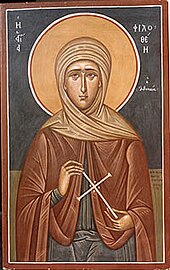Top Qs
Timeline
Chat
Perspective
February 19 (Eastern Orthodox liturgics)
From Wikipedia, the free encyclopedia
Remove ads
February 18 - Eastern Orthodox liturgical calendar - February 20

All fixed commemorations below are observed on March 4 (March 3 on leap years) by Eastern Orthodox Churches on the Old Calendar.[note 1]
For February 19th, Orthodox Churches on the Old Calendar commemorate the Saints listed on February 6.
Saints
- Apostles Archippus and Philemon of the Seventy Apostles, and Martyr Apphia (1st century)[1][2][3][4]
- Martyrs Maximus, Theodotus, Hesychius, and Asclepiodota of Adrianopolis (305-311)[1][3][5][6]
- Venerable Saints Eugene and Macarius, Priests, Confessors at Antioch (363)[1][3][7][8]
- Saint Mesrop the Translator, of Armenia (439)[1][9] (see also: February 17 - Greek)
- Venerable Rabulas of Samosata (c. 530)[1][3][10][11]
- Venerable Conon, Abbot in Palestine (555)[1][3][12][13]
- Saint Dositheus of Gaza, disciple of Saint Abba Dorotheus (7th century)[1][9][14][15]
- Venerable Sophronios, Bishop.[16]
Remove ads
Pre-Schism Western saints
- Saint Gabinus, a martyr in Rome who was related to the Emperor Diocletian, but also the brother of Pope Gaius, and father of the martyr St Susanna (c. 295)[17][18][note 2]
- Saint Quodvultdeus, Bishop of Carthage in North Africa, exiled by the Arian Genseric King of the Vandals after the capture of the city in 439 (450)[17]
- Saint Valerius (Valére), Bishop of Antibes in the south of France (c. 450)[17]
- Saint Odran, ranks as the first Christian martyr in Irish history (c. 452)[17][20][21]
- Saints Publius, Julian, Marcellus and Companions, martyrs in North Africa.[17][19]
- Saint Barbatus of Benevento, took part in the Sixth Ecumenical Council in Constantinople at which Monothelitism was condemned (682)[17][22][note 3]
- Saint Mansuetus, Archbishop of Milan and Confessor, he wrote a treatise against Monothelitism (c. 690)[17][19][23]
- Saint Beatus of Liébana, a monk at Liebana and was famous for his firm stand against Adoptionism (789)[17][note 4]
- Saint George of Lodève, a monk at Saint-Foi-de-Conques in Rouergue but later moved to Vabres and became Bishop of Lodève (c. 884)[17]
Remove ads
Post-Schism Orthodox saints
- Saint Yaroslav the Wise, son of the Varangian (Viking) Grand Prince Vladimir the Great (1054)[24] (see also: February 20 - Slavonic; and February 28)
- New Nun-martyr Philothea of Athens (1588)[1][3][25][26][note 5]
- Venerable Theodore, Abbot of Sanaxar Monastery (1791)[1][9][15][27]
- New Hieromartyr Nicetas, Hieromonk, of Epirus and Mt. Athos, at Serres (1809)[1][3][28] (see also: April 4)
- Saint Maria, desert-dweller of Olonets (1860)[29] (see also: February 9)
- Saint Nikanor (Savić) the New, Abbot of Hilandar (1990)[1][note 6]
New martyrs and confessors
Other commemorations
- Icon of the Mother of God of Cyprus (392)[30][note 7] (see also: February 16)
Icon gallery
- Saint Mesrop the Translator of Armenia.
- Saint Mansuetus, Bishop of Milan.
- Saint Yaroslav the Wise.
- New Nun-martyr Philothea of Athens.
Notes
- The notation Old Style or (OS) is sometimes used to indicate a date in the Julian Calendar (which is used by churches on the "Old Calendar").
The notation New Style or (NS), indicates a date in the Revised Julian calendar (which is used by churches on the "New Calendar"). - When Adoptionism was condemned, the saint went to the monastery of Valcavado and wrote his famous Commentary on the Apocalypse.
- See: (in Serbian) Никанор Савић. Википедију. (Serbian Wikipedia).
- The Cyprus Icon of the Mother of God. In this icon the Mother of God is depicted sitting on a throne with the Divine Infant in Her arms. There is an angel on either side of Her. The prototype of this holy icon manifested itself in the year 392 on the island of Cyprus at the tomb of Righteous Lazarus, the friend of Christ (October 17), and is kept there in a monastery. Renowned copies of the Cyprus Icon are at the Moscow’s Dormition Cathedral, and in the Nikolo-Golutvin church in the village of Stromyn, Moscow diocese (Commemorated on the Sunday of Orthodoxy). Other days commemorating the Cyprus Icon are the Day of the Holy Spirit, April 20, and July 9. Some copies of the Cyprus Icon have additional names such as "Cleansing," "Knife," and "Hawk."
Remove ads
References
Sources
Wikiwand - on
Seamless Wikipedia browsing. On steroids.
Remove ads




